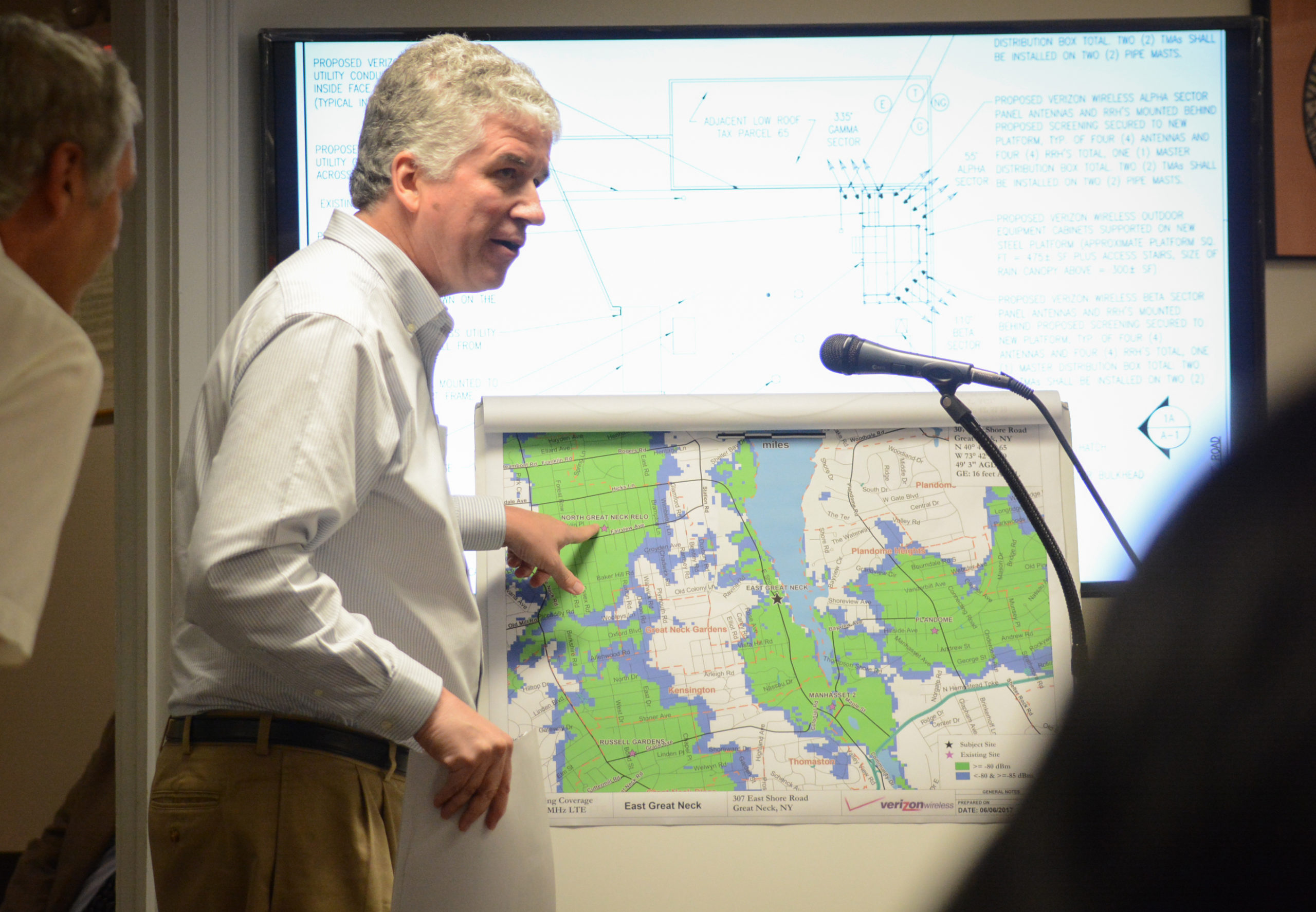Dozens of residents flooded Great Neck Village Hall to hear about and debate a proposed Verizon Wireless facility for 307 East Shore Road at a zoning board meeting Thursday night, with critics describing it as an eyesore going against village code while benefiting Manhasset more.
Representatives for Verizon Wireless came before the village board to seek a height variance that would allow antennas to be built 20 feet and three inches higher than permitted by village zoning laws.
The facility would feature a backup generator and 12 antennas, which would be divided into sectors facing the northeast, southeast, and northwest.
Verizon officials said the facility would boost cell coverage and ease pressure on their other cell facilities.
Martin Lavin, a radio frequency engineer with C-Squared Systems, said the new facility would give better coverage to more than 1,300 people while taking pressure off stations in Great Neck and Manhasset.
“They have been out of capacity for a while and the need is even more desperately needed now,” Lavin said.
Verizon representatives said the facility would be shielded on three sides and designed to match the design and texture of the building and its HVAC system.
They also noted that the building itself – 38 feet, 10 inches tall – already goes above the 31-foot maximum and their facility would only be around five feet higher than the rooftop HVAC unit and stair penthouse.
John Ellsworth, a chief environmental officer with VHB Engineering, said the visual analysis report showed the impact would be minimal due to the shielding, woods in the west and presence of other items already on the rooftop.
“Based on our analysis, we’ve concluded that the proposed facility, and particularly that’s requested from this board with regard to height, would not result in significant adverse impacts at the subject location or in the surrounding area with respect to visual resources, land use, zoning or community character,” Elsworth said.
Joseph Mineo of Pinnacle Telecom, who discussed compliance with Federal Communications Commission safety requirements, said the site would emit levels radio frequency radiation – which heats up cells – “17 times less than what is considered to be an acceptable level.”
“To put this number in perspective … the average household kitchen has an MPE level anywhere from three to seven percent of the limit,” Mineo said. “So in essence, this site is less of a hazard than you being in your own kitchen.”
Dennis Grossman, the chair of the Zoning Board of Appeals, asked whether signals are line of sight, what specific gaps would be addressed, and how old the studies were.
Grossman also noted the facility appeared aimed more at Plandome than Great Neck, drawing a strong reaction from the audience.
When Grossman asked about the specific benefit to Great Neck, both in general and compared to Plandome, some audience members called out, “none!”
Michael Shapiro, a Ruth Court resident, said he is concerned about parts of the facility crashing into his yard. He also mentioned concerns about cell phone radiation and decreased property values.
“The wooded hill area they’re talking about is my backyard,” Shapiro said. “So when they say it’s not going to affect anyone, I’m looking at it and my kids are looking at it.”
West Terrace Road resident Mark Birnbaum, who is also a village judge, said he took issue with some of the claims made.
“I can show photos to this board that I can see the roof of that building, and I resent the fact that they’re saying nothing can be seen and we’re not even going to buffer the area, which is a pretty insulting comment,” Birnbaum said, highlighting that this facility would be in a mixed-use residential zone.
Birnbaum also described this as bad for the community because of its location away from the waterfront district, the height, and history of the building owner.
“Five-story buildings are not what this village wants,” Birnbaum said. “It’s not the zoning and to say ‘it’s only another five feet’ — no. It’s two [extra] stories, it’s 21 feet, and that does severely impact all of the people that are here and the hundreds of other residents who haven’t come out.”
“This is a forever license. It will be there forever and the current owner has demonstrated, over the last decades, a disregard for the village law,” Birnbaum added, noting a lack of compliance with noise ordinances and other issues.
Jenni Lurman, an attorney who moved to Great Neck from Manhattan a year ago, said counsel for Verizon is correct in that local governments cannot take perceived health effects into account when considering a cell tower application.
But, she said, the facility could affect the community’s charm and real estate values.
“I did not move here so I could live somewhere where it’s commercial or industrial and I think as we build up in the precise location where they seek to place this hidden tower, we really change the personality of our community and our area,” said Lurman, who has two children. “We make it a less desirable place for professionals from Manhattan to move to.”
Grossman said the board wants the applicants to file an updated service deficiency report, noise assessment study, and take the 54 foot tall AvalonBay building – not in existence when Verizon began investigating sites – into consideration.
The next zoning board meeting is scheduled for Aug. 2 at 7:30 p.m.



